Characteristics and Enrichment Genesis of the Platinum Group Elements (PGEs) in Organic Rich Shale of the Wufeng and Longmaxi Formations of Upper Ordovician and Lower Silurian in the Sichuan Basin
Abstract
1. Introduction
2. Geological Setting
3. Samples and Methods
4. Analytical Results
4.1. Total Organic Carbon and Mineralogical Characteristics
4.2. Major and Trace Elements
4.3. PGEs Content and Parameter Characteristics
5. Discussion
5.1. Extraterrestrial Matter Influences
5.2. Influence of Hydrothermal Deposition
5.3. Biological Sedimentation
5.4. Indicative Significance of Sedimentary Environment
6. Conclusions
- The black shale of the Wufeng Fm and Longmaxi Fm in the CN outcrop has a high TOC and SiO2 content. A large number of radiolarian fossils have been found, indicating that they are mainly biogenic siliceous. The content of PGEs is low, relatively rich in Pt and Pd, and deficient in Ir and Ru, with an obvious Pt–Pd distribution pattern. PGEs is mainly enriched in the bottom of Longmaxi Fm, and Mo, Ni, V, U, Cu, Zn and other elements are enriched at the same time, which indicates that the sedimentary period of this period is not only the normal seawater deposition, but may be affected by submarine hydrothermal sedimentation.
- There is no obvious abnormality in Ir whose content is low, which is significantly less than that of the Cretaceous–Paleogene boundary clay layer in Denmark with typical extraterrestrial genesis. Meanwhile, there is no comparability with the values of Pd/Pt, (Pt + PD)/(OS + Ru + IR), Au/Ir and Ag/Au in carbonaceous chondrites, indicating that PGEs of the black shale is not an extraterrestrial material source.
- The trace elements Mo, Sb, V, Ba, Ni, Cr, Cu, Zn enrichment and Sr deficiency, LREE enrichment, partial samples δEun positive anomaly, the normalized PGEs distribution pattern of chondrite, the Pd/Ir and the Pt/Pd–Ir/Pd correlation diagram all show that the enrichment of PGEs is closely related to the seafloor hydrothermal process.
- PGEs and TOC, Mo, Ni, Cu, Zn and δ 34SV-CDT correlations indicate that PGEs enrichment is related not only to organic matter enrichment but also to Mo, Ni sulfide and pyrite. This may be related to the enrichment of mantle-derived materials brought by submarine hydrothermal solution in the early Longmaxi Fm. PGEs enrichment is complex and controlled by the influence of the sedimentary environment. The anoxic water body and high primary paleo-productivity in the restricted basin and hydrothermal sedimentary influence are the main factors. It could also be related to extinctions caused by abrupt climate changes or strong tectonic movements. In addition, the good positive correlation between TOC and PGEs indicates that PGEs may be used as an indicator parameter for the sedimentary environment and organic matter enrichment.
Author Contributions
Funding
Acknowledgments
Conflicts of Interest
References
- Barnes, S.J.; Naldrett, A.J.; Gorton, M.P. The origin of the fractionation of platinum-group elements in terrestrial magmas. Chem. Geol. 1985, 53, 303–323. [Google Scholar] [CrossRef]
- Gadd, M.G.; Peter, J.M.; Jackson, S.E.; Yang, Z.; Petts, D. Platinum, Pd, Mo, Au and Re deportment in hyper-enriched black shale Ni-Zn-Mo-PGE mineralization, Peel River, Yukon, Canada. Ore Geol. Rev. 2019, 107, 600–614. [Google Scholar] [CrossRef]
- Liang, Y.; Zhu, W. Disscussion on the enrichment characteristics of PGE, REE and the genesis for Ni-Mo ore deposits in Tianmenshan area northwest Hunan province. Contrib. Geol. Miner. Resour. Res. 1995, 10, 55–65, (In Chinese with English abstract). [Google Scholar]
- Yi, F.; Gao, Z. The geological and geochemical charaterstics of Platinum-group element in black rock series. Adv. Earth Sci. 1996, 11, 275–281. [Google Scholar]
- Zhang, G.; Li, J.; Xiong, Q.; Qi, F.; Zhen, M. Enrichment Features and Patterns of PGE Metals in BlackShale from Zunyi area, Guizhou Province. Miner. Depos. 2002, 21, 377–386, (In Chinese with English abstract). [Google Scholar]
- Park, J.W.; Hu, Z.; Gao, S.; Campbell, I.H.; Gong, H. Platinum group element abundances in the upper continental crust revisited—New constraints from analyses of Chinese loess. Geochim. Et Cosmochim. Acta 2012, 93, 63–76. [Google Scholar] [CrossRef]
- Zhu, Z.; Zhang, B.; Tang, Q.; Mao, L.; Shuang, Y.; Zhang, X. Sources and Geochemistry of Platinum Group Elements (PGE) in the Early Cambrian Black Rock Series in Chengkou District, Northern Dabashan. Southwest China 2017, 37, 495–506, (In Chinese with English abstract). [Google Scholar]
- Wang, J.; Ceng, P.; Ma, J. Black Rock Series and Associated Minerals: An Example of the Yangtze Platform. Geol. Explor. 2015, 51, 677–689, (In Chinese with English abstract). [Google Scholar]
- Jiang, S.; Yang, J.; Ling, H.; Chen, Y.; Feng, H.; Zhao, K.; Ni, P. Extreme enrichment of polymetallic Ni–Mo–PGE–Au in Lower Cambrian black shales of South China: An Os isotope and PGE geochemical investigation. Palaeogeogr. Palaeoclimatol. Palaeoecol. 2007, 254, 217–228. [Google Scholar] [CrossRef]
- Coveney, R.M.; Murowchick, J.B.; Grauch, R.I. Gold and platinum in shales with evidence against extraterrestrial sources of metals. Chem. Geol. 2012, 99, 101–114. [Google Scholar] [CrossRef]
- Zou, C.; Dong, D.; Wang, S.; Li, J.; Li, X.; Wang, Y.; Li, D.; Cheng, K. Geological characteristics, formation mechanism and resourcepotential of shale gas in China. Pet. Explor. Dev. 2010, 37, 641–653, (In Chinese with English abstract). [Google Scholar] [CrossRef]
- Wang, S.; Dong, D.; Wang, Y.; Li, X.; Huang, J.; Guan, Q. Sedimentary geochemical proxies for paleoenvironment interpretation of organic-rich shale: A case study of the Lower Silurian Longmaxi Formation, Southern Sichuan Basin, China. J. Nat. Gas Sci. Eng. 2016, 28, 691–699. [Google Scholar] [CrossRef]
- Gao, J.; Wang, X.; He, S.; Guo, X.; Zhang, B.; Chen, X. Geochemical characteristics and source correlation of natural gas in Jurassic shales in the North Fuling area, Eastern Sichuan Basin, China. J. Petrol. Sci. Eng. 2017, 158, 284–292. [Google Scholar] [CrossRef]
- Nie, H.; Jin, Z.; Ma, X.; Liu, Z.; Lin, T.; Yang, Z. Graptoliteszone and sedimentary characteristics of Upper Ordovician Wufeng formation-Lower Silurian Longmaxi Formation Sichuan basin and its adjacent areas. Acta Pet. Sin. 2017, 38, 160–174, (In Chinese with English abstract). [Google Scholar]
- Tang, X.; Jiang, Z.; Huang, H.; Jiang, S.; Yang, L.; Xiong, F.; Chen, L.; Feng, J. Lithofacies characteristics and its effect on gas storage of the Silurian Longmaxi marine shale in the southeast Sichuan Basin, China. J. Nat. Gas Sci. Eng. 2016, 28, 338–346. [Google Scholar] [CrossRef]
- Tuo, J.; Wu, C.; Zhang, M. Organic matter properties and shale gas potential of Paleozoic shales in Sichuan Basin, China. J. Nat. Gas Sci. Eng. 2016, 28, 434–446. [Google Scholar] [CrossRef]
- Yang, R.; He, S.; Hu, Q.; Hu, D.; Yi, J. Geochemical characteristics and origin of natural gas from Wufeng-Longmaxi shales of the Fuling gas field, Sichuan Basin (China). Int. J. Coal Geol. 2017, 171, 1–11. [Google Scholar] [CrossRef]
- Zhao, J.; Jin, Z.; Jin, Z.; Geng, Y.; Wen, X.; Yan, C. Applying sedimentary geochemical proxies for paleoenvironment interpretation of organic-rich shale deposition in the Sichuan Basin, China. Int. J. Coal Geol. 2016, 163, 52–71. [Google Scholar] [CrossRef]
- Wang, S.; Sun, X.; Shi, G. Distinction of Platinum Group Elements ( PGE) Geochemistry between the Jinbaoshan and Baimazhai Magmatic Sulf ide Deposits in Yunnan Province, China, and Its Impl ication for Ore Genesis. Acta Geol. Sin. 2007, 81, 93–108, (In Chinese with English abstract). [Google Scholar]
- Luo, Q.; Zhong, N.; Dai, N.; Zhang, W. Graptolite-derived organic matter in the Wufeng–Longmaxi Formations (Upper Ordovician–Lower Silurian) of southeastern Chongqing, China: Implications for gas shale evaluation. Int. J. Coal Geol. 2016, 153, 87–98. [Google Scholar] [CrossRef]
- Li, Y.; Zhang, T.; Ellis, G.S.; Shao, D. Depositional environment and organic matter accumulation of Upper Ordovician–Lower Silurian marine shale in the Upper Yangtze Platform, South China. Palaeogeogr. Palaeoclimatol. Palaeoecol. 2017, 466, 252–264. [Google Scholar] [CrossRef]
- Liu, H.; Jin, G.; Li, J.; Han, J.; Zang, J.; Zhang, J.; Zhong, F.; Guo, D. Determinationof stable isotope composition in uranium geological samples. World Nucl. Geosci. 2013, 30, 174–179, (In Chinese with English abstract). [Google Scholar]
- Taylor, S.R.; McLennan, S.M. The Continental Crust: Its Composition and Evolution; Blackwell Scientific Publication: Oxford, UK, 1985. [Google Scholar]
- Wang, Y.; Dong, D.; Huang, J.; Li, X.; Wang, S. Guanyinqiao Member lithofacies of the Upper Ordovician Wufeng Formationaround the Sichuan Basin and the significance to shale gas plays, SW China. Pet. Explor. Dev. 2016, 43, 42–50, (In Chinese with English abstract). [Google Scholar] [CrossRef]
- Zhou, M.; Luo, T.; Huff, W.D.; Liu, S. Prominent Lower Cambrian K-Bentonites In South China: Distribution, Mineralogy, and Geochemistry. J. Sediment. Res. 2014, 84, 842–853. [Google Scholar] [CrossRef]
- Tribovillard, N.; Algeo, T.J.; Lyons, T.; Riboulleau, A. Trace metals as paleoredox and paleoproductivity proxies: An update. Chem. Geol. 2006, 232, 12–32. [Google Scholar] [CrossRef]
- Tribovillard, N.; Algeo, T.J.; Baudin, F.; Riboulleau, A. Analysis of marine environmental conditions based onmolybdenum–uranium covariation—Applications to Mesozoic paleoceanography. Chem. Geol. 2012, 324–325, 46–58. [Google Scholar] [CrossRef]
- Taylor, S.R.; McLennan, S.M. The geochemical evolution of the continental crust. Rev. Geophys. 1995, 33, 241–265. [Google Scholar] [CrossRef]
- Algeo, T.J.; Tribovillard, N. Environmental analysis of paleoceanographic systems based on molybdenum–uranium covariation. Chem. Geol. 2009, 268, 211–225. [Google Scholar] [CrossRef]
- Tang, D.; Shi, X.; Zhao, X. Mo-U Covariation as An Important Proxy for Sedimentary Environment, Redox Conditions-Progress, Problems and Prospects. Geoscience 2015, 29, 1–13, (In Chinese with English abstract). [Google Scholar]
- Algeo, T.J.; Morford, J.; Cruse, A. Reprint of: New Applications of Trace Metals as Proxies in Marine Paleoenvironments. Chem. Geol. 2012, 324–325, 1–5. [Google Scholar] [CrossRef]
- Anbar, A.D. OCEANS: Elements and Evolution. Science 2008, 322, 1481–1483. [Google Scholar] [CrossRef] [PubMed]
- Li, Y.; LÜ, H.; Zhang, Y.; Zhang, X.; Shao, D.; Yan, J.; Zhang, T. U-Mo covariation in marine shales of Wufeng—Longmaxi Formations in Sichuan Basin. Geochimica 2015, 44, 109–116, (In Chinese with English abstract). [Google Scholar]
- Algeo, T.J.; Lyons, T.W. Mo–total organic carbon covariation in modern anoxic marine environments: Implications for analysis of paleoredox and paleohydrographic conditions. Paleoceanography 2006, 21, 279–298. [Google Scholar] [CrossRef]
- Rowe, H.D.; Loucks, R.G.; Ruppel, S.C.; Rimmer, S.M. Mississippian Barnett Formation, Fort Worth Basin, Texas: Bulk geochemical inferences and Mo–TOC constraints on the severity of hydrographic restriction. Chem. Geol. 2008, 257, 16–25. [Google Scholar] [CrossRef]
- Gromet, L.P.; Haskin, L.A.; Korotev, R.L.; Dymek, R.F. The “North American shale composite”: Its compilation, major and trace element characteristics. Geochim. Cosmochim. Acta 1984, 48, 2469–2482. [Google Scholar] [CrossRef]
- Sugitani, K.; Yamashita, F.; Nagaoka, T.; Yamamoto, K.; Minami, M.; Mimura, K.; Suzuki, K. Geochemistry and sedimentary petrology of Archean clastic sedimentary rocks at Mt. Goldsworthy, Pilbara Craton, Western Australia: Evidence for the early evolution of continental crust and hydrothermal alteration. Precambrian Res. 2006, 147, 124–147. [Google Scholar] [CrossRef]
- Bai, Y.; Liu, Z.; Sun, P.; Liu, R.; Hu, X.; Zhao, H.; Xu, Y. Rare earth and major element geochemistry of Eocene fine-grained sediments in oil shale- and coal-bearing layers of the Meihe Basin, Northeast China. J. Asian Earth Sci. 2015, 97, 89–101. [Google Scholar] [CrossRef]
- Zhang, Q.; Yu, Q.; Wang, J.; Xiao, Y.; Cheng, J.; Zhao, A.; Zhang, B. Application of ICP-MS to study the Rare Earth Element characteristics and sedimentary environment of black shale in the Longmaxi formation in the Southwestern Sichuan Basin. Rock Miner. Anal. 2018, 37, 217–224, (In Chinese with English abstract). [Google Scholar]
- Yang, B.; Bin, H.; Bao, Z.; Zhang, Z. REE geochemical characteristics and depositional environment of the black shale-hosted Baiguoyuan Ag-V deposit in Xingshan, Hubei Province, China. J. Rare Earths 2011, 29, 499–506. [Google Scholar] [CrossRef]
- Haskin, L.; Wildeman, T.; Haskin, M. An accurate procedure for the determination of the rare earths by neutron activation. J. Radioanal. Chem. 1968, 1, 337–348. [Google Scholar] [CrossRef]
- Li, T. The statistieal charaeteristies of the abundanceof chemical elements in the Earth’s Crust. Geolegy Prospect. 1992, 28, 3–9, (In Chinese with English abstract). [Google Scholar]
- Han, T.; Zhu, X.; Li, K.; Jiang, L.; Zhao, C.; Wang, Z. Metal sources for the polymetallic Ni–Mo–PGE mineralization in the black shales of the Lower Cambrian Niutitang Fm, South China. Ore Geol. Rev. 2015, 67, 158–169. [Google Scholar] [CrossRef]
- Tu, G. Research on the material composition, geological background and some peculiarities of formation mechanism of unconventional super-large ore deposit—An initial discussion on unconventional super-large ore deposit. J. Sci. China Ser. D 1998, 1–6. [Google Scholar]
- Mcdonough, W.F.; Sun, S.S. The composition of the Earth. Chem. Geol. 1995, 120, 223–253. [Google Scholar] [CrossRef]
- Han, T.; Zhu, X.; Chen, N. Occurrence of PGE in the Polymetal lic Layer of Black Shales, Zunyi, Guizhou, China. Bull. Mineral. Petrol. Geochem. 2011, 30, 142–149, (In Chinese with English abstract). [Google Scholar]
- Fan, D.; Yang, X.; Wang, L.; Chen, N. Petrological and geochemical characteristics of a nickel-molybdenum-multe-element-beaing lower-Cambrian black shale from a certain district in south China. Geochemical 1973, 3, 3–24, (in Chinese with English abstract). [Google Scholar]
- Fan, D.; Zhang, T.; Ye, J. Black Rock Series and Related Mineral Deposits in China; Science Press: Beijing, China, 2004; (In Chinese with English abstract). [Google Scholar]
- Coveney, R.M.; Nansheng, C. Ni-Mo-PGE-Au-rich ores in Chinese black shales and speculations on possible analogues in the United States. Miner. Depos. 1991, 26, 83–88. [Google Scholar] [CrossRef]
- Li, S.; Gao, Z. Tracing of noble metal elements in the black rock series of the Cambrian bottom of Hunan, Guizhou and Guizhou. Sci. China: Geosci. 2000, 30, 169–174, (In Chinese with English abstract). [Google Scholar]
- Mao, J.; Zhang, G.; Du, A.; Wang, Y.; Zeng, M. Geology, Geochemistry, and Re-Os isotopie dating of the Huang Jiawan Ni-Mo-PGE deposite, Zunyi, Guizhou Province-with a discussion of the polymetallie mineralization of basal Cambrian black shale in south China. Acta Geol. Sin. 2001, 75, 234–243, (In Chinese with English abstract). [Google Scholar]
- Xiao, Q.; Li, S.; Cai, K. Features of platinrm-group element in different mineral assemblages in the Lower Cambrian black rock series in Hunan and Guizhou. Geolegy China 2006, 33, 1083–1091, (In Chinese with English abstract). [Google Scholar]
- Liang, Y.; Li, Y. Genetic types and geological characteristics of platinum group element deposits in China. Miner. Resour. Geol. 1997, 11, 145–151, (In Chinese with English abstract). [Google Scholar]
- Ganapaty, R. A Major Meteorite Impact on the Earth 65 Million Years Ago: Evidence from the Cretaceous-Tertiary Boundary Clay. Science 1980, 209, 921–923. [Google Scholar] [CrossRef] [PubMed]
- Alvarez, L.W.; Alvarez, W.; Asaro, F.; Michel, H.V. Extraterrestrial Cause for the Cretaceous-Tertiary Extinction. Science 1981, 208, 1095–1108. [Google Scholar] [CrossRef] [PubMed]
- Kyte, F.T.; Smit, J.; Wasson, J.T. Siderophile interelement variations in the Cretaceous-Tertiary boundary sediments from Caravaca, Spain. Earth Planet. Sci. Lett. 1985, 73, 183–195. [Google Scholar] [CrossRef]
- Liu, Z.; Algeo, T.J.; Guo, X.; Fan, J.; Du, X.; Lu, Y. Paleo-environmental cyclicity in the Early Silurian Yangtze Sea (South China): Tectonic or glacio-eustatic control? Palaeogeogr. Palaeoclimatol. Palaeoecol. 2017, 466, 59–76. [Google Scholar] [CrossRef]
- Wang, M. Research Status and Prospect of Determination of Platinum Group Elements. Rare Metal Materials and Engineering. 2010, 39, 2255–2261, (In Chinese with English abstract). [Google Scholar]
- Wang, S.; Zou, C.; Dong, D.; Wang, Y.; Huang, J.; Guo, Z. Biogenic silica of organic-rich shale in Sichuan basin and its significance for shale gas. Acta Sci. Nat. Univ. Pikinensis 2014, 50, 476–486, (in Chinese with English abstract). [Google Scholar]
- Xiong, X.; Wang, J.; Yu, Q.; Yang, Y.; Xiong, G.; Niu, B.; Guo, X.; Deng, Q. Element geochemistry inversion of the environment and background of organic-rich black shale formations: A case study of the Wufeng-Longmaxi black shale in the Tianba section in mortheastern Chongqing. Nat. Gas Ind. 2015, 35, 25–32, (In Chinese with English abstract). [Google Scholar]
- Zhang, Q.; Wang, J.; Yu, Q.; Xiao, Y.; Zhang, B.; Wang, X.; Zhao, A. The Silicon Source and Sedimentary Environment of the Lower Silurian Longmaxi Formation in Yanyuan Basin, Western Edge of the Yangtze Platform. Geol. Rev. 2018, 64, 610–622, (In Chinese with English abstract). [Google Scholar]
- Wonder, J.D.; Spry, P.G.; Wendom, K.E. Geochemistry and origin of manganese-rich rocks related to iron-formation and sulfide deposits, western georgia. Econ. Geol. 1988, 83, 1070–1081. [Google Scholar] [CrossRef]
- Murray, R.W.; Ten Brink MR, B.; Gerlach, D.C.; Russ, G.P., III; Jones, D.L. Rare earth, major, and trace element composition of Monterey and DSDP chert and associated host sediment: Assessing the influence of chemical fractionation during diagenesis. Geochim. Et Cosmochim. Acta 1992, 56, 2657–2671. [Google Scholar] [CrossRef]
- Ran, B.; Liu, S.; Jansa, L.; Sun, W.; Yang, D.; Ye, Y.; Wang, S.; Luo, C.; Zhang, X.; Zhang, C. Origin of the Upper Ordovician–lower Silurian cherts of the Yangtze block, South China, and their palaeogeographic significance. J. Asian Earth Sci. 2015, 108, 1–17. [Google Scholar] [CrossRef]
- Pašava, J.; Vymazalová, A.; Petersen, S.; Herzig, P. PGE distribution in massive sulfides from the PACMANUS hydrothermal field, eastern Manus basin, Papua New Guinea: Implications for PGE enrichment in some ancient volcanogenic massive sulfide deposits. Miner. Depos. 2004, 39, 784–792. [Google Scholar] [CrossRef]
- Sun, X.; Wang, S.; Sun, W.; Shi, G.; Sun, Y.; Xiong, D.; Qu, W.; Du, A. PGE geochemistry and Re–Os dating of massive sulfide ores from the Baimazhai Cu–Ni deposit, Yunnan province, China. Lithos 2008, 105, 12–24. [Google Scholar] [CrossRef]
- Pašava, J.; Barnes, S.J.; Vymazalová, A. The use of mantle normalization and metal ratios in the identification of the sources of platinum-group elements in various metal-rich black shales. Miner. Depos. 2003, 38, 775–783. [Google Scholar] [CrossRef]
- Yao, D.; Zhang, L.; Wiltshire, J.C.; Chu, F.; Du, A.; Liu, X.; Yang, F. PGE and Re-Os Isotope composition and their significances of Co-rich ferromanganese crusts. Mar. Geol. Quat. Geol. 2002, 22, 55–60, (In Chinese with English abstract). [Google Scholar]
- Cao, J.; Zhou, J.; Bian, L.; Shi, C.; Yao, S. Organic clots and their differential accumulation of Ni and Mo within early Cambrian black-shale-hosted polymetallic Ni-Mo deposits, Zunyi, South China. J. Asian Earth Ences 2013, 2013, 531–536. [Google Scholar] [CrossRef]
- Shi, C.; Cao, J.; Hu, K.; Bian, L.; Yao, S.; Zhou, J.; Han, S. New understandings of Ni–Mo mineralization in early Cambrian black shales of South China: Constraints from variations in organic matter in metallic and non-metallic intervals. Ore Geol. Rev. 2014, 59, 73–82. [Google Scholar] [CrossRef]
- Plyusnina, L.P.; Kyz’Mina, T.V.; Likhoidov, G.G.; Narnov, G.A. Experimental modeling of platinum sorption on organic matter. Appl. Geochem. 2000, 15, 777–784. [Google Scholar] [CrossRef]
- Jiang, Y. Introduction of the research on submarine hydrothermal sedex mineral deposits in the black rock series. Contrib. Geol. Miner. Resour. Res. 2010, 25, 177–187, (In Chinese with English abstract). [Google Scholar]
- Chen, X.; Wang, X. Biota and organic matter in late Sinian and Earlycambrian black rock series of west Hunan and their significance to metallization. Acta Geol. Sin. 1998, 379, 16–23, (In Chinese with English abstract). [Google Scholar]
- Wu, C.; Shen, Y.; Hou, Q. Geochemical characteristics and enrichment factors of platinum group elements of the black rock series in western hunan. Prog. Nat. Sci. State Key Lab. Commun. 2011, 11, 507–513, (In Chinese with English abstract). [Google Scholar]
- Wang, M. Geology, Geochemistry and Genesis of PGE Polymetallic Deposits in the Lower Cambrian BlackRock Series, Southern China; Acta Scientiarum Naturalium Universitatis Sunyatseni: Guangzhou, China, 2004; Volume 43, pp. 98–102, (In Chinese with English abstract). [Google Scholar]
- Guo, X.; Hu, D.; Wei, Z.; Li, Y.; Wei, X. Discovery and exploration of Fuling shale gas field. China Pet. Explor. 2016, 21, 24–37, (in Chinese with English abstract). [Google Scholar]
- Zou, C.; Zhao, Q.; Dong, D.; Zhi, Y.; Zhen, Q.; Feng, L.; Nan, W.; Yong, H.; Duan, A.; Qin, Z. Geological characteristics, main challenges and future prospect of shale gas. J. Nat. Gas Geosci. 2017, 28, 1781–1796. [Google Scholar] [CrossRef]
- Ma, Y.; Fan, M.; Lu, Y.; Guo, X.; Hu, H.; Chen, L.; Wang, C.; Liu, X. Geochemistry and sedimentology of the Lower Silurian Longmaxi mudstone in southwestern China: Implications for depositional controls on organic matter accumulation. Mar. Pet. Geol. 2016, 75, 291–309. [Google Scholar] [CrossRef]
- Yang, R.; He, S.; Wang, X.; Hu, Q.; Hu, D.; Yi, J.; Widory, D. Paleo-ocean redox environments of the Upper Ordovician Wufeng and the first member in lower Silurian Longmaxi formations in the Jiaoshiba area, Sichuan Basin. Can. J. Earth Sci. 2016, 53, 426–440. [Google Scholar] [CrossRef]
- Nägler, T.F.; Siebert, C.; Lüschen, H.; Böttcher, M.E. Sedimentary Mo isotope record across the Holocene fresh–brackish water transition of the Black Sea. Chem. Geol. 2005, 219, 283–295. [Google Scholar] [CrossRef]
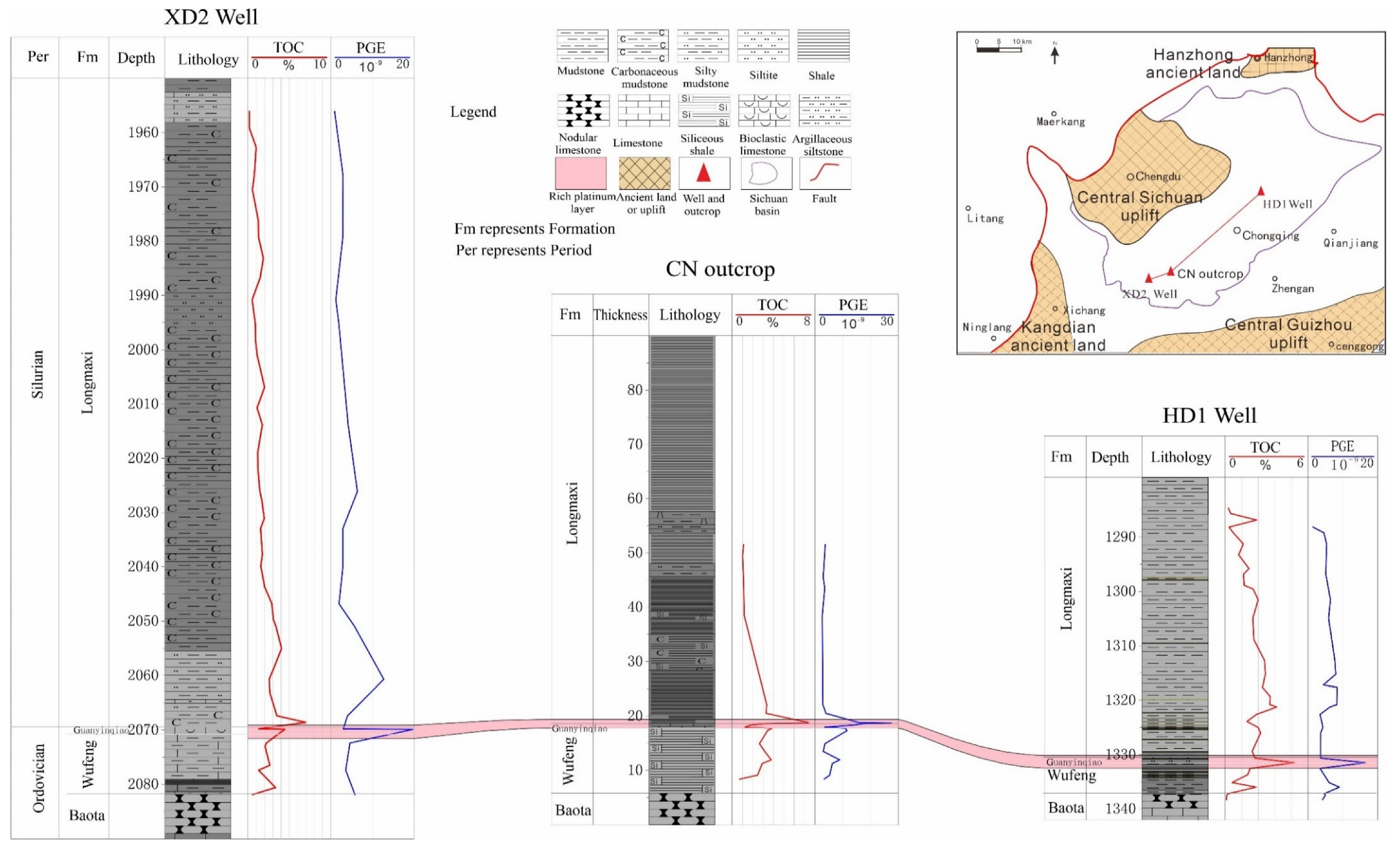

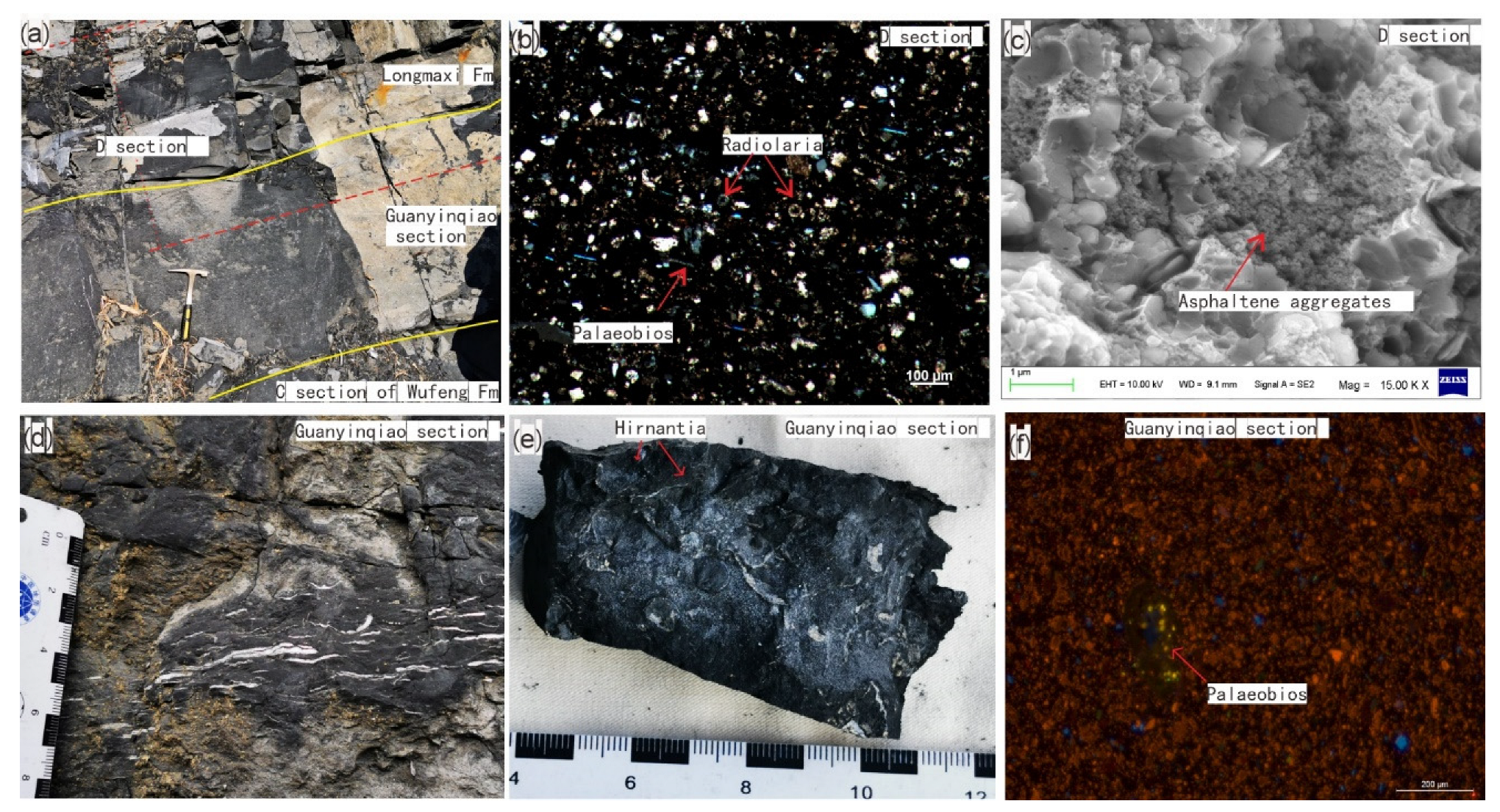
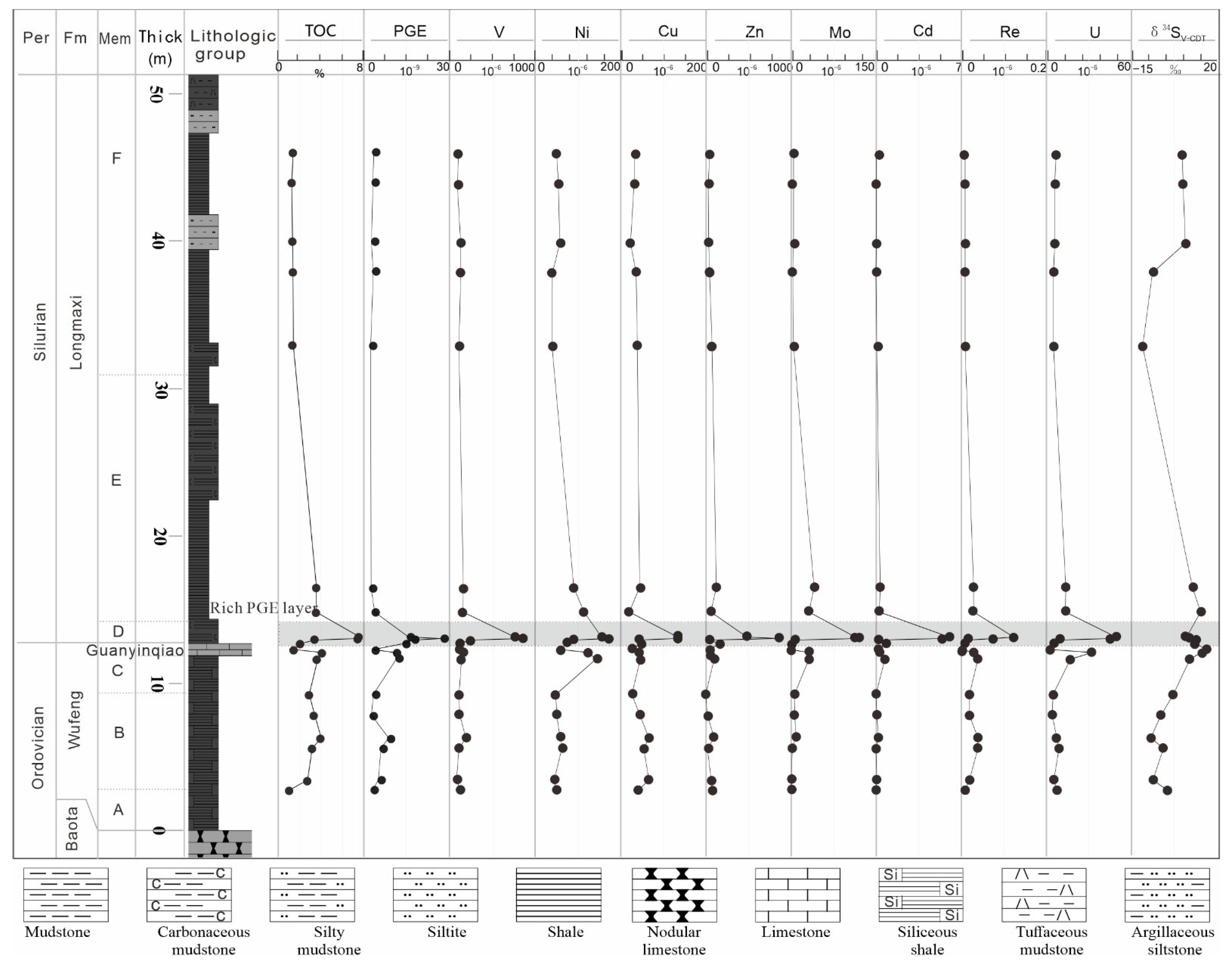


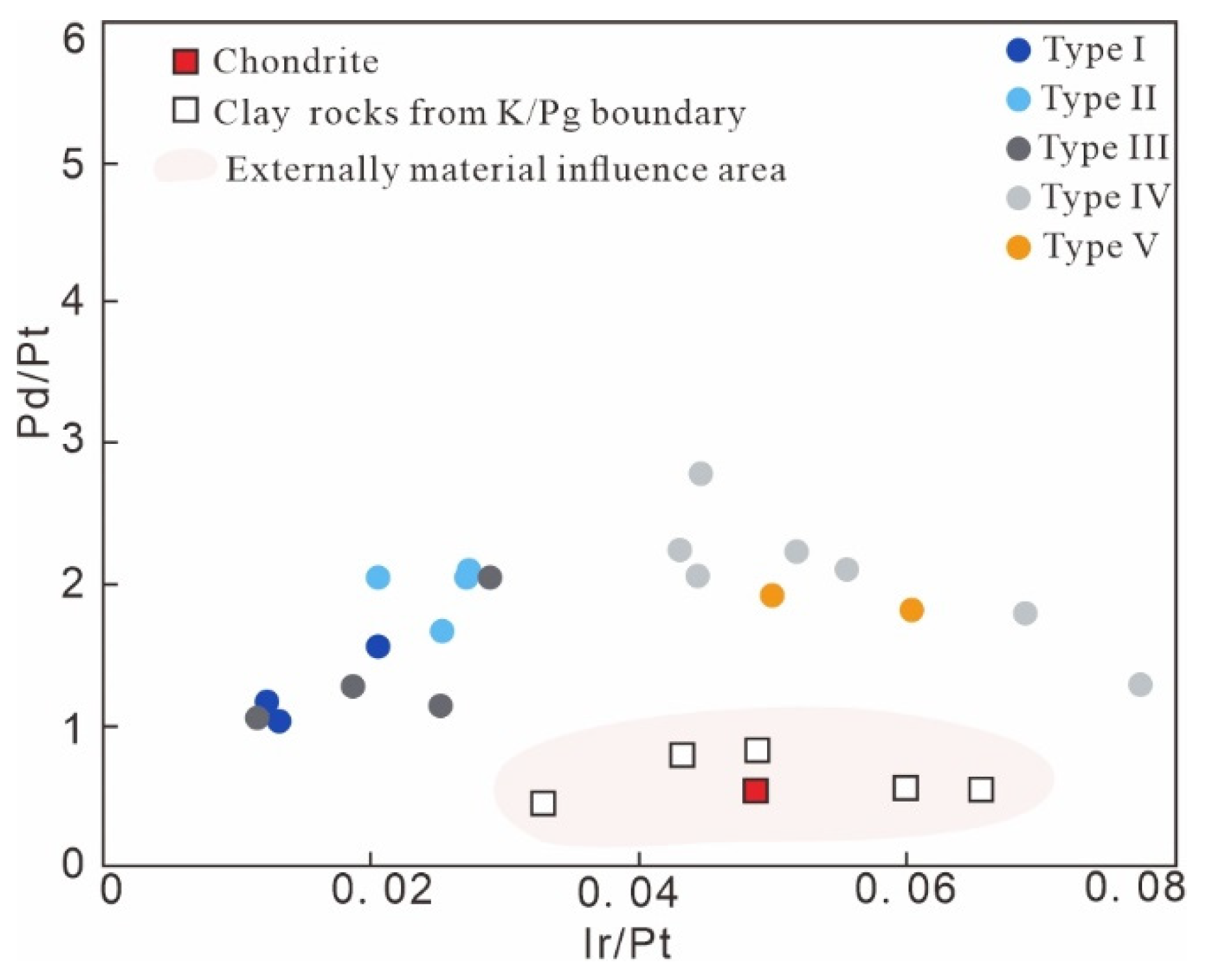
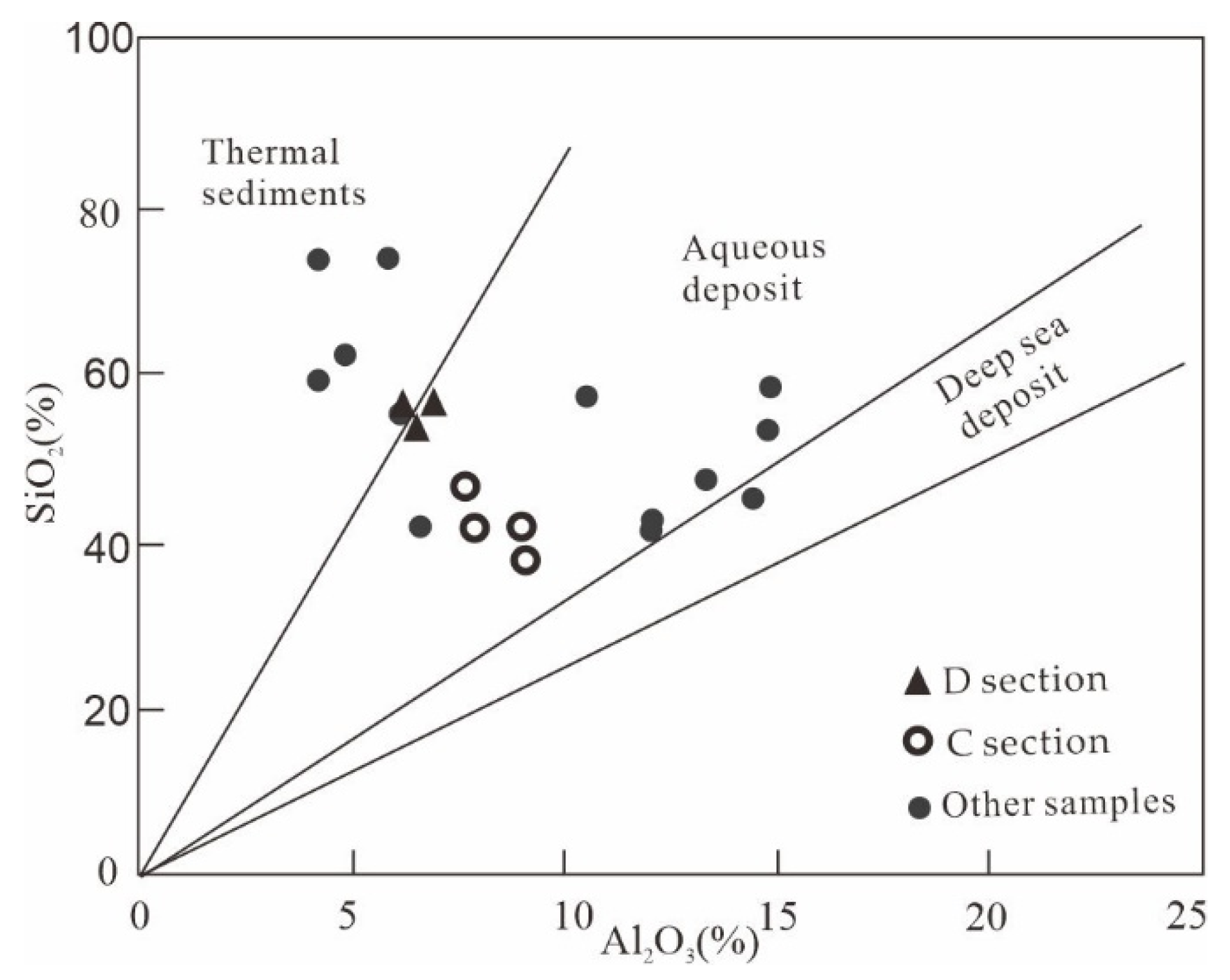
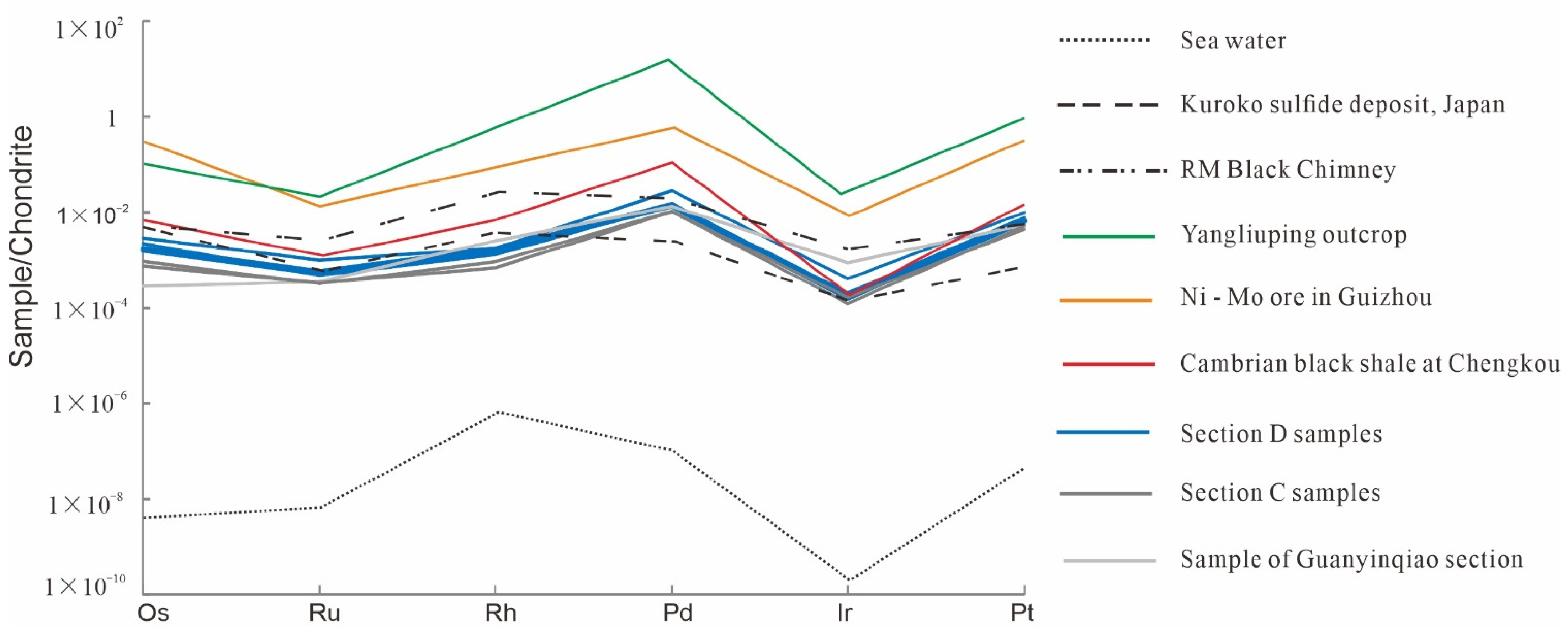
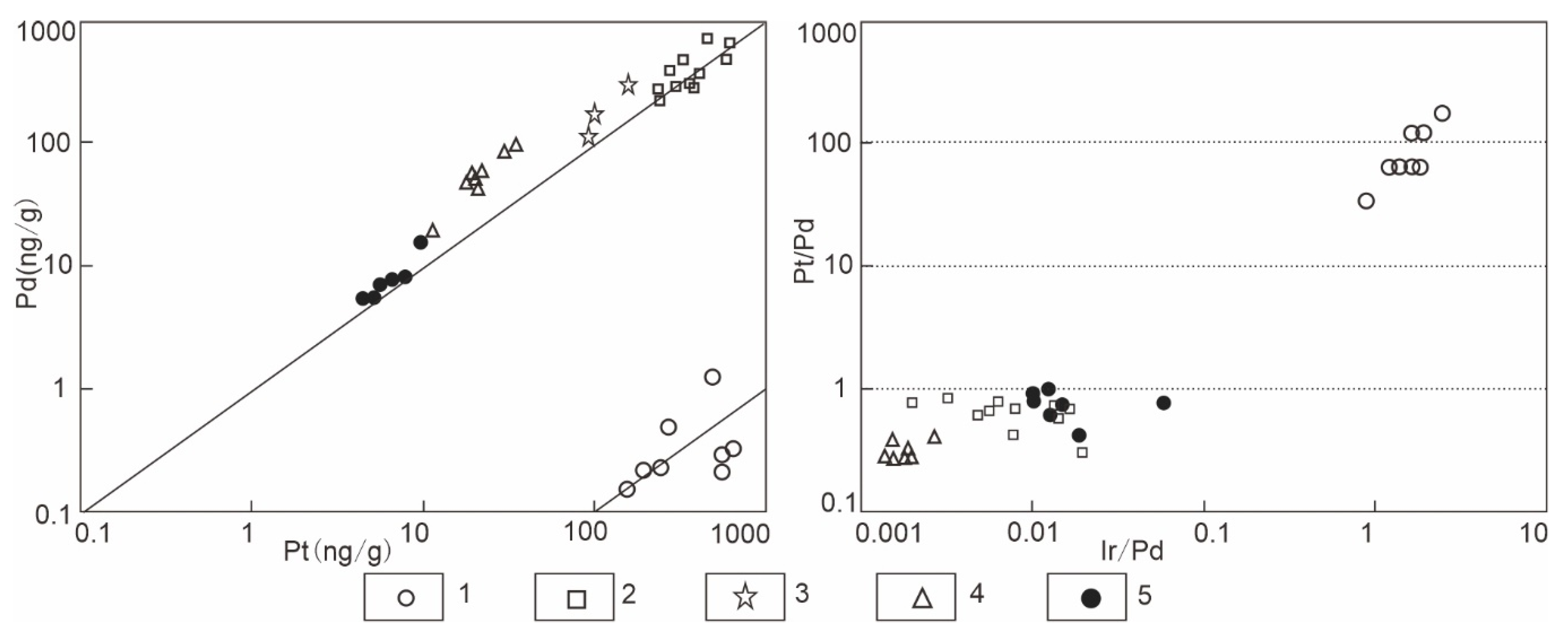

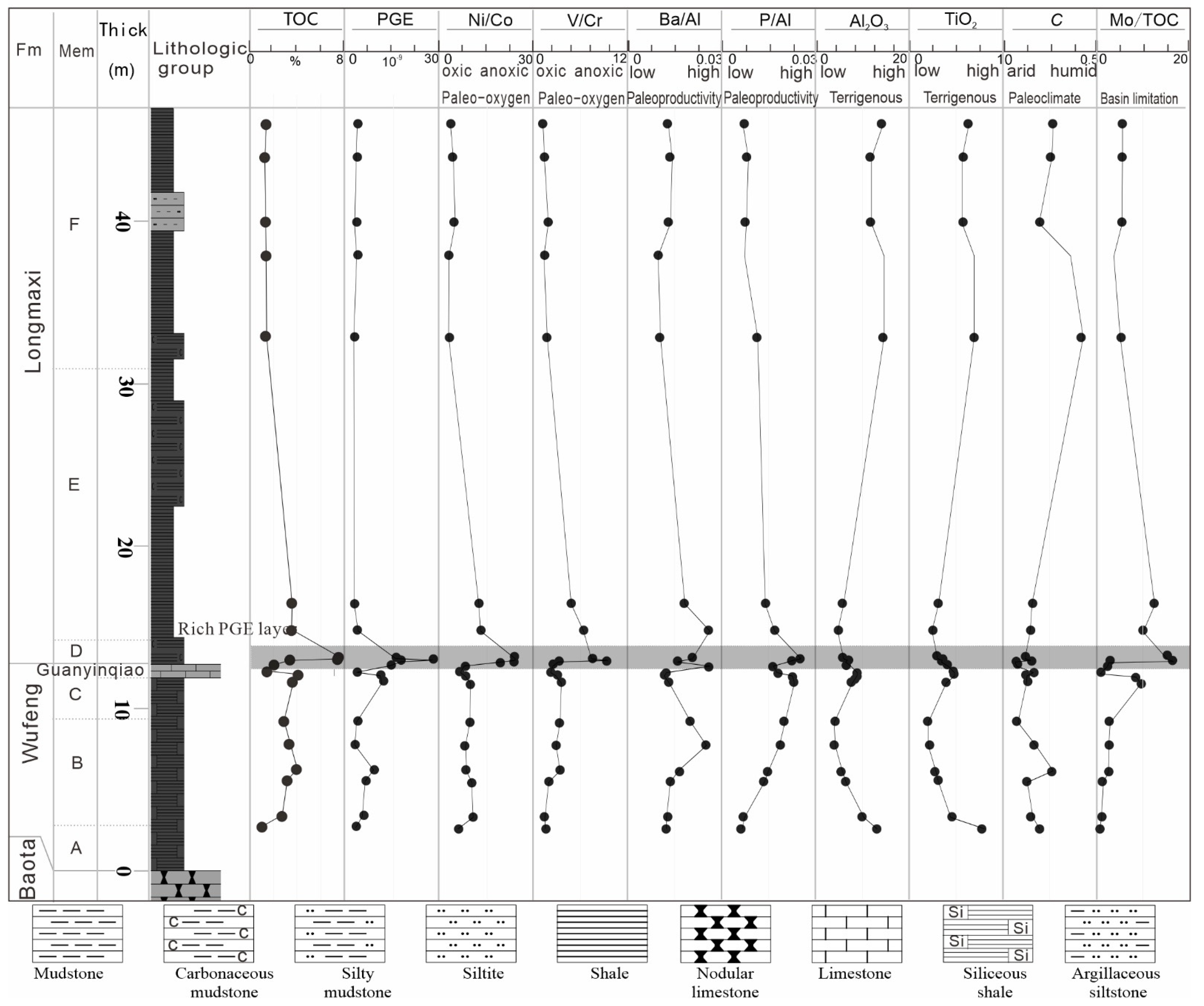
| Sample No. | Fm | TOC % | Clay (%) | Carbo Nate (%) | Quartz + feldspar(%) | SiO2 (%) | Al2O3 (%) | Fe2O3 (%) | MgO (%) | CaO (%) | Na2O (%) | K2O (%) | MnO (%) | TiO2 (%) | P2O5 (%) | LOI (%) | δ34SV-CDT (‰) |
|---|---|---|---|---|---|---|---|---|---|---|---|---|---|---|---|---|---|
| Y1 | S1l | 1.10 | 45 | 31 | 23 | 44.08 | 14.48 | 4.91 | 3.87 | 9.04 | 0.89 | 3.96 | 0.05 | 0.64 | 0.10 | 15.64 | 5.90 |
| Y2 | S1l | 1.01 | 43 | 30 | 26 | 41.22 | 12.05 | 5.24 | 4.50 | 11.05 | 0.93 | 3.36 | 0.08 | 0.57 | 0.11 | 18.22 | 6.10 |
| Y3 | S1l | 1.09 | 41 | 35 | 23 | 42.20 | 12.09 | 4.07 | 3.33 | 12.40 | 1.52 | 3.28 | 0.06 | 0.57 | 0.10 | 18.34 | 7.00 |
| Y4 | S1l | 1.12 | 50 | 16 | 30 | 53.30 | 14.83 | 5.21 | 3.52 | 4.10 | 2.26 | 4.07 | 0.05 | 0.70 | 0.11 | 10.23 | −6.50 |
| Y5 | S1l | 1.16 | 54 | 9 | 35 | 57.66 | 14.83 | 5.23 | 2.95 | 2.77 | 1.84 | 4.03 | 0.03 | 0.70 | 0.18 | 8.30 | −10.50 |
| Y6 | S1l | 3.34 | 20 | 24 | 51 | 55.06 | 6.22 | 2.28 | 3.18 | 9.33 | 0.48 | 1.65 | 0.03 | 0.32 | 0.09 | 17.57 | 10.10 |
| Y7 | S1l | 3.29 | 14 | 22 | 61 | 62.10 | 4.88 | 1.85 | 1.83 | 8.68 | 0.95 | 1.28 | 0.03 | 0.25 | 0.08 | 15.23 | 13.40 |
| Y8 | S1l | 7.40 | 25 | 20 | 50 | 56.64 | 6.19 | 1.48 | 2.32 | 7.32 | 2.27 | 1.53 | 0.03 | 0.31 | 0.16 | 19.36 | 7.50 |
| Y9 | S1l | 7.25 | 28 | 20 | 50 | 55.86 | 6.97 | 1.93 | 2.38 | 8.54 | 0.99 | 1.79 | 0.03 | 0.36 | 0.16 | 18.84 | 9.30 |
| Y10 | S1l | 3.18 | 19 | 28 | 52 | 53.68 | 6.56 | 1.20 | 1.83 | 13.31 | 2.07 | 1.69 | 0.05 | 0.35 | 0.14 | 17.49 | 11.70 |
| Y11 | O3g | 1.77 | 29 | 37 | 32 | 46.64 | 7.65 | 1.61 | 1.95 | 17.00 | 1.08 | 2.00 | 0.07 | 0.42 | 0.13 | 19.38 | 11.40 |
| Y12 | O3g | 1.24 | 25 | 41 | 32 | 38.28 | 9.09 | 3.73 | 3.30 | 14.38 | 2.69 | 2.48 | 0.11 | 0.49 | 0.16 | 19.82 | 15.70 |
| Y13 | O3w | 3.86 | 34 | 35 | 30 | 41.42 | 9.04 | 2.59 | 2.66 | 14.76 | 0.70 | 2.34 | 0.07 | 0.49 | 0.21 | 22.24 | 13.50 |
| Y14 | O3w | 3.42 | 30 | 35 | 32 | 41.57 | 8.01 | 2.63 | 2.59 | 14.20 | 2.02 | 2.08 | 0.06 | 0.40 | 0.19 | 22.45 | 9.00 |
| Y15 | O3w | 2.64 | 12 | 31 | 55 | 59.15 | 4.24 | 1.27 | 1.57 | 12.44 | 0.93 | 1.13 | 0.06 | 0.21 | 0.09 | 17.61 | 2.10 |
| Y16 | O3w | 3.15 | 19 | 17 | 60 | 73.14 | 4.37 | 1.44 | 1.19 | 5.32 | 0.47 | 1.12 | 0.03 | 0.21 | 0.08 | 10.69 | −2.90 |
| Y17 | O3w | 3.78 | 25 | 7 | 63 | 73.13 | 5.89 | 1.80 | 1.39 | 3.51 | 0.22 | 1.56 | 0.03 | 0.29 | 0.09 | 10.28 | −7.10 |
| Y18 | O3w | 2.91 | 28 | 44 | 25 | 41.53 | 6.65 | 2.70 | 6.16 | 14.01 | 0.11 | 1.87 | 0.15 | 0.32 | 0.09 | 24.86 | −1.80 |
| Y19 | O3w | 2.46 | 39 | 22 | 37 | 56.90 | 10.47 | 2.22 | 2.30 | 7.64 | 0.81 | 2.80 | 0.07 | 0.45 | 0.08 | 14.61 | −6.20 |
| Y20 | O3w | 0.74 | 47 | 25 | 27 | 46.49 | 13.29 | 3.77 | 3.51 | 8.80 | 2.70 | 3.95 | 0.11 | 0.81 | 0.09 | 14.94 | −0.30 |
| UCC value | 65.89 | 15.17 | 4.49 | 2.20 | 4.19 | 3.89 | 3.39 | 0.07 | 0.50 | 0.20 | |||||||
| Oxide/UCC | 0.79 | 0.59 | 0.64 | 1.28 | 2.37 | 0.33 | 0.71 | 0.88 | 0.89 | 0.61 | |||||||
| Sample No. | Fm. | V (ug/g) | Co (μg/g) | Ni (μg/g) | Cu (μg/g) | Zn (μg/g) | Mo (μg/g) | U (μg/g) | MoEF | UEF | Mo/ TOC | ΣREE (μg/g) | LREE(μg/g) | HRE(μg/g) | δEuN | δEuS | δCeS |
|---|---|---|---|---|---|---|---|---|---|---|---|---|---|---|---|---|---|
| Y1 | S1l | 114.3 | 14.2 | 52.5 | 36.0 | 55.5 | 6.2 | 6.9 | 4.3 | 2.6 | 5.6 | 168.7 | 153.2 | 15.6 | 1.17 | 1.79 | 0.92 |
| Y2 | S1l | 101.0 | 12.4 | 57.5 | 34.4 | 39.5 | 5.6 | 6.1 | 4.7 | 2.8 | 5.6 | 176.6 | 159.6 | 16.9 | 1.04 | 1.59 | 0.91 |
| Y3 | S1l | 140.6 | 11.5 | 59.8 | 25.8 | 47.0 | 6.0 | 5.9 | 5.1 | 2.6 | 5.5 | 149.3 | 134.8 | 14.5 | 1.16 | 1.78 | 0.91 |
| Y4 | S1l | 139.0 | 13.0 | 43.2 | 38.9 | 54.1 | 4.2 | 5.0 | 2.8 | 1.8 | 3.7 | 168.9 | 154.0 | 14.9 | 1.02 | 1.56 | 0.94 |
| Y5 | S1l | 119.4 | 13.5 | 42.4 | 42.3 | 84.0 | 5.9 | 5.1 | 4.0 | 1.9 | 5.1 | 176.9 | 162.0 | 14.8 | 0.98 | 1.50 | 0.93 |
| Y6 | S1l | 169.6 | 7.3 | 93.0 | 47.0 | 133.8 | 42.0 | 13.7 | 68.3 | 11.9 | 12.6 | 102.9 | 92.9 | 10.0 | 1.05 | 1.60 | 0.87 |
| Y7 | S1l | 164.4 | 8.7 | 116.6 | 22.9 | 72.5 | 33.4 | 13.5 | 69.2 | 15.0 | 10.2 | 81.8 | 72.9 | 8.9 | 1.29 | 1.97 | 0.86 |
| Y8 | S1l | 774.7 | 6.5 | 158.5 | 137.3 | 496.8 | 114.4 | 49.2 | 186.9 | 43.1 | 15.5 | 102.3 | 90.4 | 11.9 | 1.07 | 1.63 | 0.76 |
| Y9 | S1l | 876.1 | 7.2 | 175.1 | 134.3 | 866.2 | 120.9 | 45.1 | 175.4 | 35.1 | 16.7 | 133.1 | 118.6 | 14.5 | 0.73 | 1.11 | 0.84 |
| Y10 | S1l | 252.1 | 4.6 | 92.1 | 42.8 | 54.5 | 8.3 | 9.8 | 12.8 | 8.1 | 2.6 | 93.9 | 82.5 | 11.4 | 0.79 | 1.20 | 0.86 |
| Y11 | O3g | 131.7 | 9.5 | 76.5 | 47.5 | 168.6 | 4.0 | 5.5 | 5.3 | 3.9 | 2.3 | 96.8 | 84.5 | 12.2 | 0.93 | 1.42 | 0.90 |
| Y12 | O3g | 128.7 | 9.0 | 62.7 | 28.6 | 60.7 | 0.8 | 3.1 | 0.9 | 1.8 | 0.7 | 139.5 | 125.1 | 14.4 | 0.69 | 1.05 | 0.91 |
| Y13 | O3w | 169.5 | 15.2 | 127.0 | 44.6 | 58.2 | 33.2 | 32.3 | 37.2 | 19.4 | 8.6 | 180.4 | 159.8 | 20.5 | 0.77 | 1.17 | 0.85 |
| Y14 | O3w | 151.3 | 14.3 | 145.4 | 48.9 | 108.4 | 32.9 | 17.1 | 41.5 | 11.6 | 9.6 | 173.3 | 153.7 | 19.6 | 0.71 | 1.09 | 0.86 |
| Y15 | O3w | 117.8 | 5.1 | 50.6 | 29.4 | 10.4 | 7.5 | 4.8 | 18.0 | 6.2 | 2.9 | 88.8 | 78.1 | 10.8 | 0.93 | 1.42 | 0.91 |
| Y16 | O3w | 128.1 | 6.3 | 53.4 | 48.2 | 31.9 | 8.1 | 4.1 | 18.7 | 5.1 | 2.6 | 90.5 | 81.7 | 8.8 | 0.97 | 1.49 | 0.94 |
| Y17 | O3w | 200.1 | 6.8 | 61.0 | 68.6 | 108.3 | 9.4 | 7.4 | 16.2 | 6.8 | 2.5 | 101.4 | 92.0 | 9.4 | 0.88 | 1.34 | 0.89 |
| Y18 | O3w | 118.4 | 6.1 | 64.6 | 57.5 | 28.0 | 4.0 | 8.9 | 6.1 | 7.2 | 1.4 | 150.9 | 132.6 | 18.3 | 0.75 | 1.15 | 0.83 |
| Y19 | O3w | 91.9 | 4.3 | 47.0 | 68.5 | 73.2 | 2.4 | 5.4 | 2.4 | 2.8 | 1.0 | 281.7 | 260.5 | 21.2 | 0.65 | 0.99 | 0.93 |
| Y20 | O3w | 133.4 | 8.2 | 50.8 | 44.4 | 83.9 | 0.5 | 7.6 | 0.4 | 3.1 | 0.6 | 197.0 | 181.8 | 15.3 | 1.06 | 1.62 | 0.99 |
| PAAS | 60.0 | 10.0 | 20.0 | 25.0 | 71.0 | 1.5 | 2.8 | 183.0 | |||||||||
| EF | 6.0 | 1.6 | 7.0 | 3.6 | 3.2 | 25.6 | 7.8 | ||||||||||
| Sample No. | Fm. | Os(ng/g) | Ir(ng/g) | Ru(ng/g) | Rh(ng/g) | Pt(ng/g) | Pd(ng/g) | Ag(μg/g) | PGEs(ng/g) | Pd/Pt | Pd/(Pd + Pt) | Pd/Ir | (Pt + Pd)/(Os + Ru + Ir) |
|---|---|---|---|---|---|---|---|---|---|---|---|---|---|
| Y1 | S1l | 0.12 | 0.05 | 0.21 | 0.07 | 0.97 | 2.18 | 0.11 | 3.60 | 2.25 | 0.69 | 43.60 | 8.29 |
| Y2 | S1l | 0.18 | 0.05 | 0.22 | 0.06 | 0.91 | 1.94 | 0.12 | 3.36 | 2.13 | 0.68 | 38.80 | 6.33 |
| Y3 | S1l | 0.18 | 0.04 | 0.19 | 0.06 | 0.81 | 1.58 | 0.10 | 2.86 | 1.95 | 0.66 | 39.50 | 5.83 |
| Y4 | S1l | 0.19 | 0.06 | 0.23 | 0.07 | 1.00 | 1.87 | 0.10 | 3.42 | 1.87 | 0.65 | 31.17 | 5.98 |
| Y5 | S1l | 0.15 | 0.05 | 0.22 | 0.05 | 0.73 | 1.33 | 0.10 | 2.53 | 1.82 | 0.65 | 26.60 | 4.90 |
| Y6 | S1l | 0.35 | 0.08 | 0.16 | 0.04 | 0.70 | 1.39 | 0.24 | 2.72 | 1.99 | 0.67 | 17.38 | 3.54 |
| Y7 | S1l | 0.31 | 0.03 | 0.23 | 0.06 | 1.21 | 2.01 | 0.36 | 3.85 | 1.66 | 0.62 | 67.00 | 5.65 |
| Y8 | S1l | 0.76 | 0.08 | 0.39 | 0.21 | 6.69 | 7.74 | 1.61 | 15.87 | 1.16 | 0.54 | 96.75 | 11.73 |
| Y9 | S1l | 1.31 | 0.20 | 0.70 | 0.23 | 9.80 | 15.40 | 1.67 | 27.64 | 1.57 | 0.61 | 77.00 | 11.40 |
| Y10 | S1l | 1.01 | 0.10 | 0.34 | 0.17 | 7.80 | 8.12 | 3.09 | 17.54 | 1.04 | 0.51 | 81.20 | 10.98 |
| Y11 | O3g | 0.13 | 0.43 | 0.25 | 0.33 | 5.55 | 7.29 | 0.65 | 13.98 | 1.31 | 0.57 | 16.95 | 15.85 |
| Y12 | O3g | 0.09 | 0.04 | 0.18 | 0.06 | 0.93 | 2.11 | 0.71 | 3.41 | 2.27 | 0.69 | 52.75 | 9.81 |
| Y13 | O3w | 0.43 | 0.08 | 0.23 | 0.12 | 4.39 | 5.71 | 0.51 | 10.96 | 1.30 | 0.57 | 71.38 | 13.65 |
| Y14 | O3w | 0.34 | 0.06 | 0.24 | 0.09 | 5.12 | 5.67 | 0.51 | 11.52 | 1.11 | 0.53 | 94.50 | 16.86 |
| Y15 | O3w | 0.24 | 0.02 | 0.16 | 0.07 | 0.98 | 2.03 | 0.25 | 3.50 | 2.07 | 0.67 | 101.50 | 7.17 |
| Y16 | O3w | 0.35 | 0.02 | 0.16 | 0.07 | 0.74 | 1.53 | 0.24 | 2.87 | 2.07 | 0.67 | 76.50 | 4.28 |
| Y17 | O3w | 0.40 | 0.07 | 0.33 | 0.15 | 2.55 | 5.35 | 0.29 | 8.85 | 2.10 | 0.68 | 76.43 | 9.88 |
| Y18 | O3w | 0.24 | 0.05 | 0.32 | 0.10 | 1.77 | 3.68 | 0.20 | 6.16 | 2.08 | 0.68 | 73.60 | 8.93 |
| Y19 | O3w | 0.23 | 0.04 | 0.30 | 0.07 | 1.49 | 3.10 | 0.22 | 5.23 | 2.08 | 0.68 | 77.50 | 8.05 |
| Y20 | O3w | 0.12 | 0.04 | 0.17 | 0.08 | 0.91 | 1.90 | 0.18 | 3.22 | 2.09 | 0.68 | 47.50 | 8.52 |
| average value | 0.36 | 0.08 | 0.26 | 0.11 | 2.75 | 4.10 | 0.56 | 7.65 | 1.80 | 0.63 | 60.38 | 8.88 | |
| Mantle value | 3.40 | 3.2 | 5.0 | 0.9 | 7.1 | 3.9 | 0.008 | 23.5 | |||||
| C1 Chondrite value | 490 | 455 | 710 | 130 | 1010 | 550 | 0.20 | 3345 | |||||
Publisher’s Note: MDPI stays neutral with regard to jurisdictional claims in published maps and institutional affiliations. |
© 2022 by the authors. Licensee MDPI, Basel, Switzerland. This article is an open access article distributed under the terms and conditions of the Creative Commons Attribution (CC BY) license (https://creativecommons.org/licenses/by/4.0/).
Share and Cite
Zhang, Q.; Men, Y.; Yu, Q.; Wang, G.; Xiao, Y.; Zhang, H.; Zhao, A.; Zhou, Y.; Cao, J. Characteristics and Enrichment Genesis of the Platinum Group Elements (PGEs) in Organic Rich Shale of the Wufeng and Longmaxi Formations of Upper Ordovician and Lower Silurian in the Sichuan Basin. Minerals 2022, 12, 1363. https://doi.org/10.3390/min12111363
Zhang Q, Men Y, Yu Q, Wang G, Xiao Y, Zhang H, Zhao A, Zhou Y, Cao J. Characteristics and Enrichment Genesis of the Platinum Group Elements (PGEs) in Organic Rich Shale of the Wufeng and Longmaxi Formations of Upper Ordovician and Lower Silurian in the Sichuan Basin. Minerals. 2022; 12(11):1363. https://doi.org/10.3390/min12111363
Chicago/Turabian StyleZhang, Qian, Yupeng Men, Qian Yu, Guozhi Wang, Yuanfu Xiao, Haiquan Zhang, Ankun Zhao, Yexin Zhou, and Junfeng Cao. 2022. "Characteristics and Enrichment Genesis of the Platinum Group Elements (PGEs) in Organic Rich Shale of the Wufeng and Longmaxi Formations of Upper Ordovician and Lower Silurian in the Sichuan Basin" Minerals 12, no. 11: 1363. https://doi.org/10.3390/min12111363
APA StyleZhang, Q., Men, Y., Yu, Q., Wang, G., Xiao, Y., Zhang, H., Zhao, A., Zhou, Y., & Cao, J. (2022). Characteristics and Enrichment Genesis of the Platinum Group Elements (PGEs) in Organic Rich Shale of the Wufeng and Longmaxi Formations of Upper Ordovician and Lower Silurian in the Sichuan Basin. Minerals, 12(11), 1363. https://doi.org/10.3390/min12111363





